Robert E. Lee And The Army Of Northern Virginia Invade The North
July 1, 1863
Confederate General Robert E. Lee and his invading Army of Northern Virginia were on the march into Maryland and Pennsylvania in June of 1863. This is Lee’s second attempt to invade the North, his failed first attempt being Antietam in September of 1862. Washington, D.C. was Lee’s goal for this second Confederate invasion, he was hoping for a negotiated end to the Civil War and a Southern victory.
Lee’s plans of Confederate invasion and victory would die at the Battle of Gettysburg.
A New Commander For The Army Of The Potomac
The Army of the Potomac gained a new commander immediately before Gettysburg. At the end of June, Abraham Lincoln decided that General Joseph “Fighting Joe” Hooker was not the kind of fighting man needed to lead the Army of the Potomac. On June 28, Major General George Gordon Meade becomes Lincoln’s new commander of the Army of the Potomac.Meade would not have long to become familiar with his new position before he faced a huge challenge. Only three days after becoming the commander of the Army of the Potomac, Meade would battle against Confederate General Robert E. Lee and the invading Army of Northern Virginia at a quiet and peaceful crossroads town in Pennsylvania named Gettysburg.
John Buford Holds The High Ground For The Union
Rebels Search For Shoes
The Battle of Gettysburg began on July 1, 1863.Early that morning Confederate soldiers belonging to General Henry Heth’s division of A. P. Hill’s corps met up with unmounted Union cavalry led by General John Buford. The Confederates were heading towards Gettysburg looking for supplies. The resulting skirmish on the outskirts of Gettysburg was the beginning of the three-day battle.
General John Buford’s cavalry arrived at Gettysburg only slightly before the Confederate troops. General Buford realized Gettysburg was a key position because of the many roads from all directions leading into the town, and because of the high ridges and hills which made up Gettysburg’s terrain.
Buford’s unmounted cavalry successfully held off three times their number for two hours, crucially allowing time for more Union troops to arrive. Buford’s clear and quick thinking allowed the Union troops to occupy the high ground of Gettysburg. This was a very important advantage for the Army of the Potomac at Gettysburg.
Major General John Reynolds Falls At Gettysburg
Major General John Reynolds arrived on the field at Gettysburg at approximately 8:30 in the morning. Buford’s cavalry had held the high ground for the Union, and now they were under heavy fire and pressure from the advancing and gathering Confederates. Reynolds and the infantry Union I Corps were needed to relieve General John Buford’s unmounted cavalry. Reynolds met with Buford at the Lutheran Seminary and decided to hold the field position. Reynolds then rode to the field to direct the Union I Corps.
“The enemy is advancing in strong force. I will fight him inch by inch, and if driven into the town I will barricade the streets and hold him back as long as possible.“
…Words of General John Reynolds at Gettysburg on July 1, 1863.
“Forward! For God’s sake, forward!“
…General John Reynolds at Gettysburg on July 1, 1863 shortly before being struck in the head and killed instantly by a Confederate sharpshooter’s minie bullet. At the time, Reynolds was directing Meredith’s Brigade into position at the edge of McPherson’s woods.
John Reynolds was 43-years-old and a brilliant soldier who would be missed by the Army of the Potomac. Reynolds was born only fifty miles from Gettysburg at Lancaster, Pennsylvania. Three days after his death, Reynolds was buried at nearby Lancaster. Today, when you tour the Gettysburg National Military Park, you will find a statue where Reynolds fell on McPherson’s Ridge.
The Iron Brigade
The fighting was furious by afternoon of the first day as all nearby Confederate and Union troops made hurried tracks for Gettysburg. A division of the Union I Corps met the rebel assault and stopped it after hard fighting. This division of the Union I Corps had a unit made up of five regiments from the Midwest that was known as the Iron Brigade. The Iron Brigade was distinctive because its members wore black hats, also making it distinctive was its reputation for tough fighting.The Iron Brigade lived up to its hard-fighting reputation at Gettysburg, but paid a dear price as two-thirds of its black-hatted members were lost in the battle.
General O. O. Howard’s 11th Corps arrived north of Gettysburg around noon and faced units of General Ewell’s 2nd Corps who were arriving after a fast march from the Susquehanna. More and more troops from both sides rushed to Gettysburg and eventually approximately 24,000 rebels faced approximately 19,000 Yankees. The Yankees formed along a line in the shape of a semicircle running north and west of Gettysburg.
Robert E. Lee Arrives At Gettysburg And The Yankees Retreat
Ewell Should Attack “If Practicable”
Lee arrived at Gettysburg and ordered Generals Hill and Ewell to send all they had against the Union lines. With this Confederate onslaught, the Yankees began to retreat through Gettysburg towards the high ground of Cemetery Hill. Fighting continued street by street, house by house, and yard by yard as the Yankees retreated.The Union retreat through Gettysburg was harried, hurried, and full of confusion. Approximately two or three thousand Yankees were captured as they tried to escape through the streets of Gettysburg. Not knowing the layout of the town streets led to confusion and entanglement for the fleeing Yankees. The men in blue could never be sure when they ran down an unfamiliar Gettysburg street… there might be Confederates waiting for them behind a house or hidden in an alley, or the street may lead them to safety.
Afterward, some of the Yankee soldiers joked about the situation. They said the rebels caught them because the names of some of their 11th Corps officers had tripped them up. Some of the names of the 11th Corps officers were: Lieutenant Colonel Detleo Von Einsiedel, Colonel Waldimir Kryzanowski, and Brigadier General Alexander Schimmelpfennig.
The Confederates pushed the retreating Yankees through the town of Gettysburg until General Winfield Scott Hancock organized strong Union positions on the high ground of Culp’s Hill and Cemetery Hill. General Howard had earlier placed a reserve division and artillery on Cemetery Hill. The Confederate advance ended late in the afternoon of July 1.
Lee ordered General Richard Ewell to renew the attack on the Yankee troops before night fell. In his orders to Ewell, Lee said the attack should happen “if practicable.” However, General Ewell thought his men needed rest, and renewing the attack on the Yankee-held high ground was impracticable. Ewell chose not to attack.
Yankees Hold The High Ground
General Meade Arrives
At the close of the first day of the Battle of Gettysburg, the Union held the high ground of Culp’s Hill and Cemetery Hill. During the night, General Meade and three more Union corps arrived at Gettysburg.The Yankees held a formidable defensive position. Their lines stretched two miles in the shape of an inverted hook around Culp’s Hill, Cemetery Hill, and another hill named Little Round Top.
The Union held a convex interior line at Gettysburg. Picture a rainbow. The Union troops are inside the rainbow and the Confederates are on the outside of the rainbow’s arc. This meant the Yankees were able to move their troops faster from position to position than the rebels could move theirs, and communication was faster too for the Yankees because the distance between the Union troops was less.
Holding the high ground was an important advantage for the Union at Gettysburg.
The First Day at Gettysburg – Gettysburg National Military Park Ranger John Nicholas
NEXT: Gettysburg, The Second Day
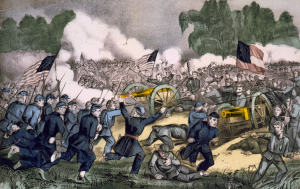
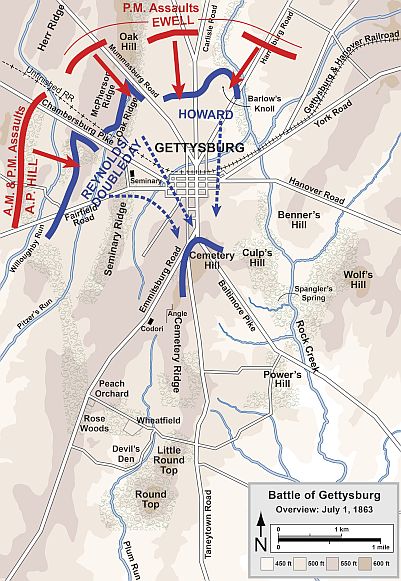
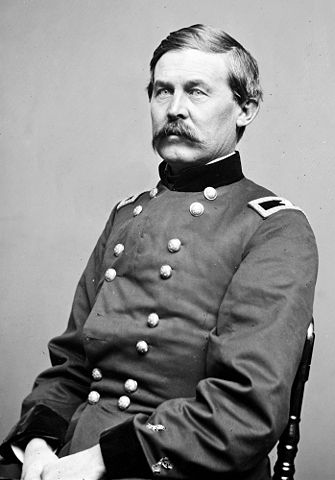
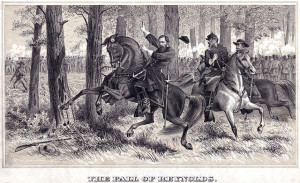
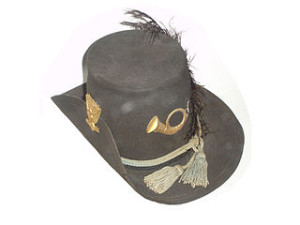
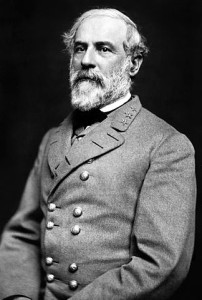
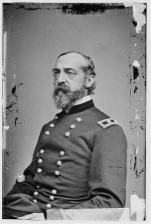

Thanks for what you do
I hope my efforts help people learn about the Civil War.